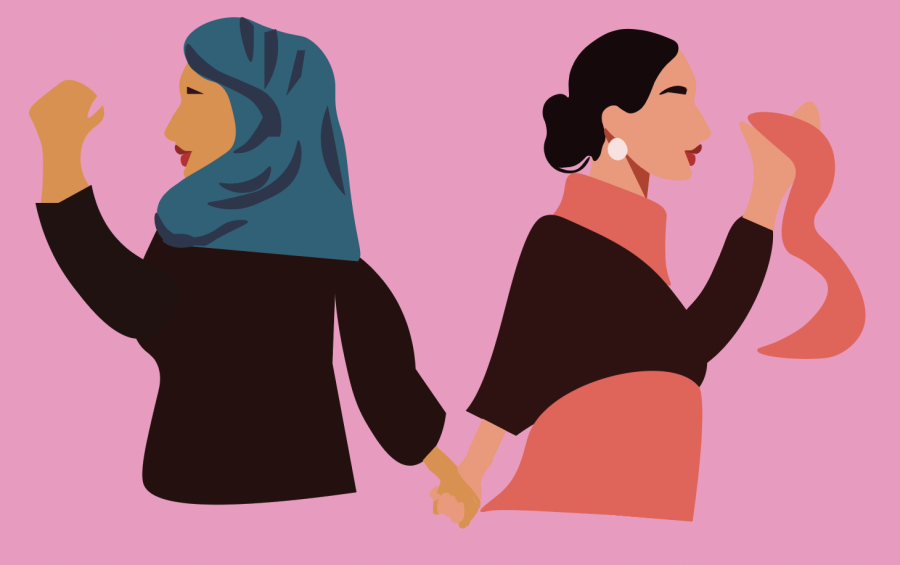Woman rising worldwide
The contrasting protests in Iran and India both exemplify the universal struggle for bodily autonomy that is central to all human rights’ movements around the world.
Global equality, with the totality and universality of its demands, can be at once as demanding as it is inspiring. While the rights of American women are being stripped away through reproductive health laws, the voices of women in the Islamic world have left the globe trembling; their songs of individual freedom bellowing with the core themes of human rights. If equality on an international scale is to be achieved, these themes must reverberate in the hymns of all its advocates.
Since mid-September, the streets of Tehran, Iran’s capital, have been echoing with the voices, chants and cries of the Iranian people. These nation-wide protests come as a response to the brutal detention, beating and subsequent death of 22-year-old Mahsa Amini, who the government claimed was caught wearing an “improper” hijab.
Just hours after Amini’s execution the protests began to ferment, making her a martyr for Iran’s latest pro-democracy, anti-theocratic monarchy movement. Over the course of a few weeks the movement has grown, prompting the Iranian government to increase its police and military presence in urban areas as well as cutting the internet to hinder the organization efforts of the Iranian people, according to the largest independent news station in the Islamic world, Al Jazeera. Still, almost a month later the protests persist, continuing to call for women to be free of the state’s religious extremism.
Almost three thousand miles away, Indian women have similarly taken to the streets. For years, the large 14.2% Muslim minority in India has faced persecution by the country’s 78.9% predominantly Hindu majority according to Pew Research Center. Muslim women have faced both widespread subjective violence in the form of attacks and lynchings, and subjective violence, in the form of social and economic anti-Muslim legislation, according to NPR. The most recent instance of these subjective policies comes in the form of a new dress code within some Indian public schools, banning the ability for Muslim girls to wear a hijab. This decision triggered thousands of Muslim schoolgirls to begin rallying, and soon protests spread to several Muslim schools across India. This historic movement seeks to retain the religious freedoms that many Indian Muslims hold dear, calling for these women’s right to express their religion however they choose.
“I feel as though these movements resonate with women so much because they have lived under patriarchal rule for centuries, and this is the breaking point,” said senior Mariam Aguilar. “Even in a theocratic government such as the one in Iran, women should not be forced to wear a hijab, as it is not always a representation of their faith.”
When learning about these recent developments, many have been left rather confused. At first glance, it is rather curious how these two movements, both of which seemingly appear to be centered around women’s liberation and empowerment, hold such opposing positions. In Iran, women are fighting to discard the mandatory usage of hijabs, while in India, women are fighting for the right to wear their hijabs. The confusion arises due to a mischaracterization of these struggles as being either for or against hijabs, when in reality these protests seek to gain one thing in particular: freedom. Both countries’ women are equally pursuing the freedom to do as they please with themselves and their bodies. Each struggle for bodily autonomy occurs in accordance to the subjective situation women find themselves in. Iranian women are imprisoned under their hijabs, so they seek to free themselves by removing it. Indian women’s chains prevent them from wearing their hijabs, so their emancipation comes through the ability to wear it.
“Both countries seem to have very opposite values,” said senior Juliette Brasselet. “However, the fundamental idea behind those different values is the same, these women fight for independence and a certain freedom to make their own choices.”
This understanding of women’s liberation in the form of freedom through bodily autonomy serves as a lesson for feminists in all parts of the world. Here in the U.S., there is not a widespread concern over the usage of hijabs, but there is a seemingly daily erosion of reproductive rights like the right to an abortion. With the recent Supreme Court decision to overturn Roe v. Wade via Dobbs v. Jackson Women’s Health Organization, followed by the restricting of abortions and contraceptives that’s occurred in Florida and other states according to the Guttmacher Institute, the women’s rights movement in the U.S. seems to be losing ground while those in Iran and India are progressing.
Perhaps, in order to more effectively resist oppressive legislation, Americans should take inspiration from these movements and not simply hint at a more equal world. Instead, like that of Iranian and Indian women, feminist advocacy should center around the affirmation of bodily autonomy in achieving woman’s “radical” freedom.
Your donation will support the student journalists of Coral Gables Senior High School. Your contribution will help us cover our annual website hosting costs.











